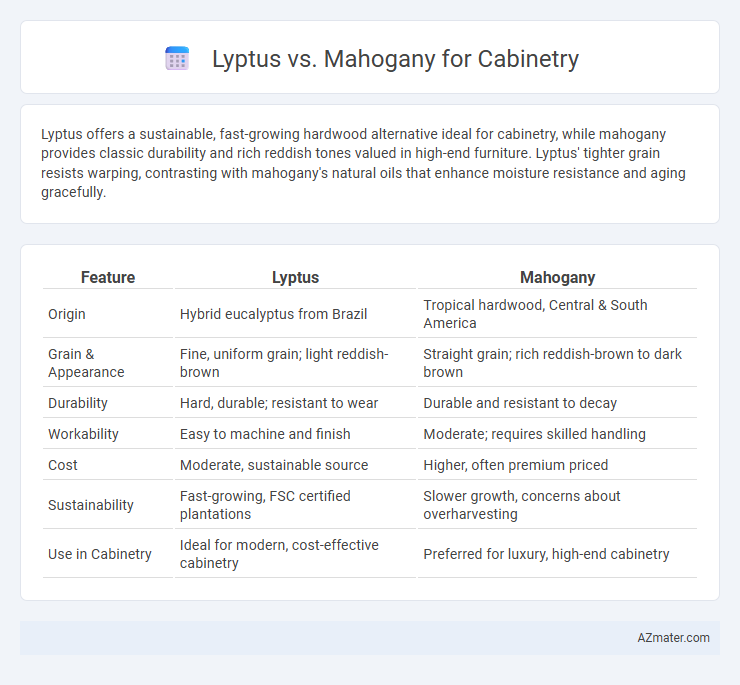Lyptus offers a sustainable, fast-growing hardwood alternative ideal for cabinetry, while mahogany provides classic durability and rich reddish tones valued in high-end furniture. Lyptus' tighter grain resists warping, contrasting with mahogany's natural oils that enhance moisture resistance and aging gracefully.
Table of Comparison
| Feature | Lyptus | Mahogany |
|---|---|---|
| Origin | Hybrid eucalyptus from Brazil | Tropical hardwood, Central & South America |
| Grain & Appearance | Fine, uniform grain; light reddish-brown | Straight grain; rich reddish-brown to dark brown |
| Durability | Hard, durable; resistant to wear | Durable and resistant to decay |
| Workability | Easy to machine and finish | Moderate; requires skilled handling |
| Cost | Moderate, sustainable source | Higher, often premium priced |
| Sustainability | Fast-growing, FSC certified plantations | Slower growth, concerns about overharvesting |
| Use in Cabinetry | Ideal for modern, cost-effective cabinetry | Preferred for luxury, high-end cabinetry |
Introduction to Lyptus and Mahogany for Cabinetry
Lyptus, a fast-growing Eucalyptus hybrid from South America, offers a sustainable alternative to traditional hardwoods with its dense grain and light reddish hue, making it ideal for cabinetry that requires durability and a smooth finish. Mahogany, prized for its rich reddish-brown color and exceptional workability, has long been favored in cabinetry for its resistance to warping and ability to take stain evenly. Both woods provide unique aesthetic and functional qualities, with Lyptus emphasizing eco-friendliness and rapid growth, while Mahogany highlights classic elegance and historical value in fine woodworking.
Wood Origin and Sustainability
Lyptus is a hybrid eucalyptus tree grown primarily in South America, known for its rapid growth and renewable forestry practices, making it a highly sustainable choice for cabinetry. Mahogany, traditionally sourced from tropical regions in Central and South America, faces sustainability challenges due to slower growth rates and overharvesting concerns impacting natural populations. Choosing Lyptus supports environmentally responsible forestry with managed plantations, whereas Mahogany requires careful certification to ensure sustainable sourcing.
Appearance and Grain Patterns
Lyptus offers a lighter, more uniform reddish-brown color with a fine, consistent grain pattern that creates a modern and sleek appearance for cabinetry. Mahogany features a deeper, richer reddish-brown hue with complex, interlocking grain patterns and occasional figuring, providing a classic, luxurious look. The choice between Lyptus and mahogany depends on whether a more uniform, contemporary aesthetic or a traditional, richly textured appearance is desired.
Durability and Hardness Comparison
Lyptus is an engineered hardwood known for its exceptional hardness, rating around 1900 on the Janka scale, making it highly resistant to dents and scratches, ideal for heavy-use cabinetry. Mahogany, with a Janka hardness of approximately 800-900, offers moderate durability but excels in workability and rich color rather than hardness. For cabinetry requiring high resistance to wear and impact, Lyptus outperforms Mahogany in durability and long-term maintenance.
Workability and Machining
Lyptus, a hybrid eucalyptus wood, offers excellent workability due to its uniform grain and hardness, allowing smooth cutting, drilling, and sanding, making it ideal for detailed cabinetry work. Mahogany, prized for its fine grain and moderate hardness, provides superior machinability and holds intricate shapes well, reducing tool wear and enabling precise joinery. Both woods perform well in CNC machining and hand tools, but Lyptus tends to resist splintering more, while Mahogany excels in finishing, resulting in durable and aesthetically pleasing cabinets.
Finishing and Staining Capabilities
Lyptus offers a uniform grain and density that accepts stains and finishes evenly, producing a consistent color and smooth surface ideal for cabinetry. Mahogany exhibits a natural reddish-brown hue that enhances with oil finishes and takes stain well, allowing for rich, warm tones with varied grain highlights. Both woods respond well to sealing and topcoats, but Lyptus' tighter grain offers a more predictable and smooth finish, while Mahogany provides depth and character through its natural grain variations.
Cost and Availability
Lyptus is generally more affordable than mahogany, offering a cost-effective alternative for cabinetry without sacrificing durability. Its faster growth rate and sustainable harvesting make Lyptus more readily available in the market compared to the slower-growing, hardwood mahogany. Mahogany's higher price reflects its premium status and limited supply, often reserved for luxury cabinetry projects.
Environmental Impact
Lyptus, a hybrid eucalyptus species, offers a sustainable alternative to traditional hardwoods, as it grows rapidly and is harvested from managed plantations, reducing deforestation pressure. Mahogany, often sourced from tropical rainforests, faces significant environmental concerns due to illegal logging and slow growth rates, leading to habitat loss and biodiversity decline. Choosing Lyptus for cabinetry significantly lowers carbon footprints and supports responsible forestry practices compared to the ecological risks associated with mahogany.
Common Applications in Cabinetry
Lyptus and mahogany are both popular woods in cabinetry due to their durability and aesthetic appeal. Lyptus, a hybrid Eucalyptus, is commonly used for modern cabinetry and furniture, offering a consistent grain and eco-friendly sourcing. Mahogany's rich color and fine grain make it favored for high-end, traditional cabinetry, particularly in luxury kitchens and custom millwork.
Final Verdict: Choosing Between Lyptus and Mahogany
Lyptus offers a sustainable and cost-effective alternative to traditional mahogany, featuring a dense, uniform grain ideal for modern cabinetry. Mahogany is prized for its rich color, durability, and classic appeal, making it a top choice for high-end, timeless cabinetry projects. Selecting between lyptus and mahogany depends on budget constraints, environmental considerations, and aesthetic preferences, with mahogany excelling in luxury applications and lyptus suited for eco-friendly, affordable designs.

Infographic: Lyptus vs Mahogany for Cabinetry
 azmater.com
azmater.com